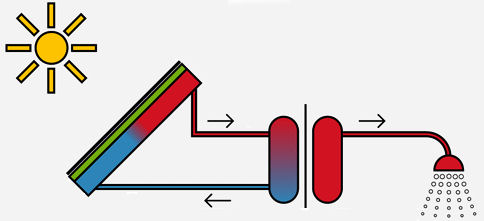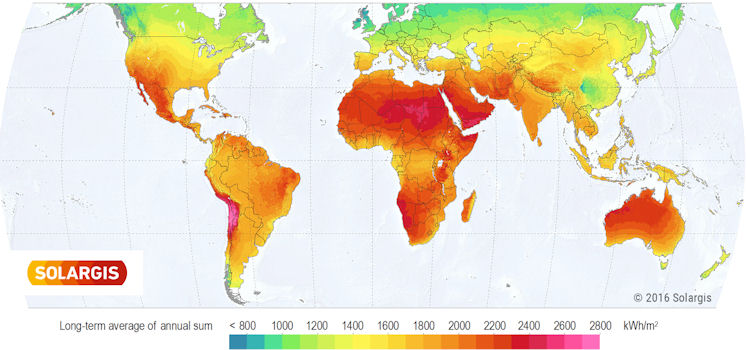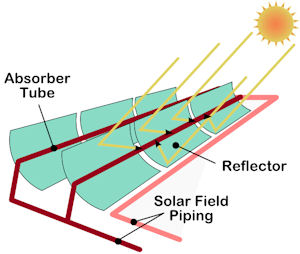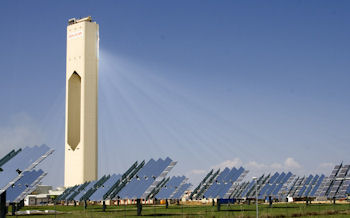


'Solar heat' or 'solar thermal energy' means the conversion of solar energy into a technically usable heat.
For example, the figure at the left shows how a heat exchanger on the roof and
heat storage in a house can help with hot water.

The figure above, GHI Solar Map © 2016 Solargis, presents the range 700−2800 kWh per m2 for the average performance over a year of solar radiation on Earth. In Las Vegas, the solar yield is twice that of Chicago. Therefore, the southwestern US is a favorite place for solar thermal energy (STE). Solar energy is transformed into thermal energy and in solar power plants subsequently converted into electricity with proven techniques. The most commonly used method for solar heat collects solar radiation by reflectors.

Parabolic trough power plants use a curved, mirrored trough which reflects the direct solar radiation onto a glass tube (also called a receiver, absorber or collector) running the length of the trough, positioned at the focal point of the reflectors. The trough is parabolic along one axis and linear in the orthogonal axis, see figure. For a change of the daily position of the sun perpendicular to the receiver, the trough tilts east to west so that the direct radiation remains focused on the receiver, which transfers the heat to a pipe with superheated steam or thermal oil. In the former case, the steam can work the turbine directly, and in the latter case a heat exchanger is needed. In 2013, the largest plant of its kind went on grid 70 miles southwest of Phoenix, near Gila Bend, Arizona. Solana Station has a capacity of 280 MW, covers 7 km² and uses 3 200 parabolic mirrors. As the sun doesn’t always shine in Arizona, the average annual output expected is about 20% of the installed capacity. At night, there is the option to use the turbines by combustion of gas, in order to satisfy power demand. Another 280-MW-station, Mojave Solar, went on grid in 2014 in Barstow, California.

In a solar tower plant, a combustion chamber in the tower receives the solar energy from a large field of reflectors. More than a thousand automatically positioned mirrors (heliostats) reflect sunlight toward the central absorber (receiver). Temperatures easily exceed 1,000 °F. Molten nitrate salt, steam, or hot air can be used as the heat transfer medium. If a large reservoir of the heat transfer medium is used, the turbines of the power plant can produce electricity at any time. The picture to the right shows PS10. Since 2009, Planta Solar 20 (PS20) near Seville in Spain obtains sunlight from 1,255 mirrors (surface area of 1,3 square feet or 0.1 m² for each) via a 165 m (531 feet)-high tower and converts it to an output of 20 MW. In February 2014, the Ivanpah Solar Electric Generating System with the power of 392 MW became the largest solar thermal power system in the world, located in Ivanpah Dry Lake, California. The system with three solar power towers was built on desert land with a mirror area of 2.6 km2. Since the end of 2023, Ivanpah is number three in the list of solar thermal power stations. The largest site (700 MW CSP + 1 500 PV) is be the Mohammed bin Rashid Al Maktoum Solar Park. It is spread over a total area of 77 km2 in Seih Al-Dahal, about 50 kilometers south of the city of Dubai.
A solar updraft tower plant is enormous. It combines three old and proven technologies: the chimney effect, the greenhouse effect, and the wind turbine. Air is heated by sunshine and the resulting convection causes the air to rise up the updraft tower and drive the turbines. A pilot plant was operated in Manzanares in Spain for several years. A power of only 50 kW was provided with a collector diameter of 244 m and a stack height of 195 m. There are currently no updraft power plants working or under construction. Plans to build solar updraft towers with capacities up to 400 MW, up to 1.5 km high and area diameter up to 7 km, were not realized.